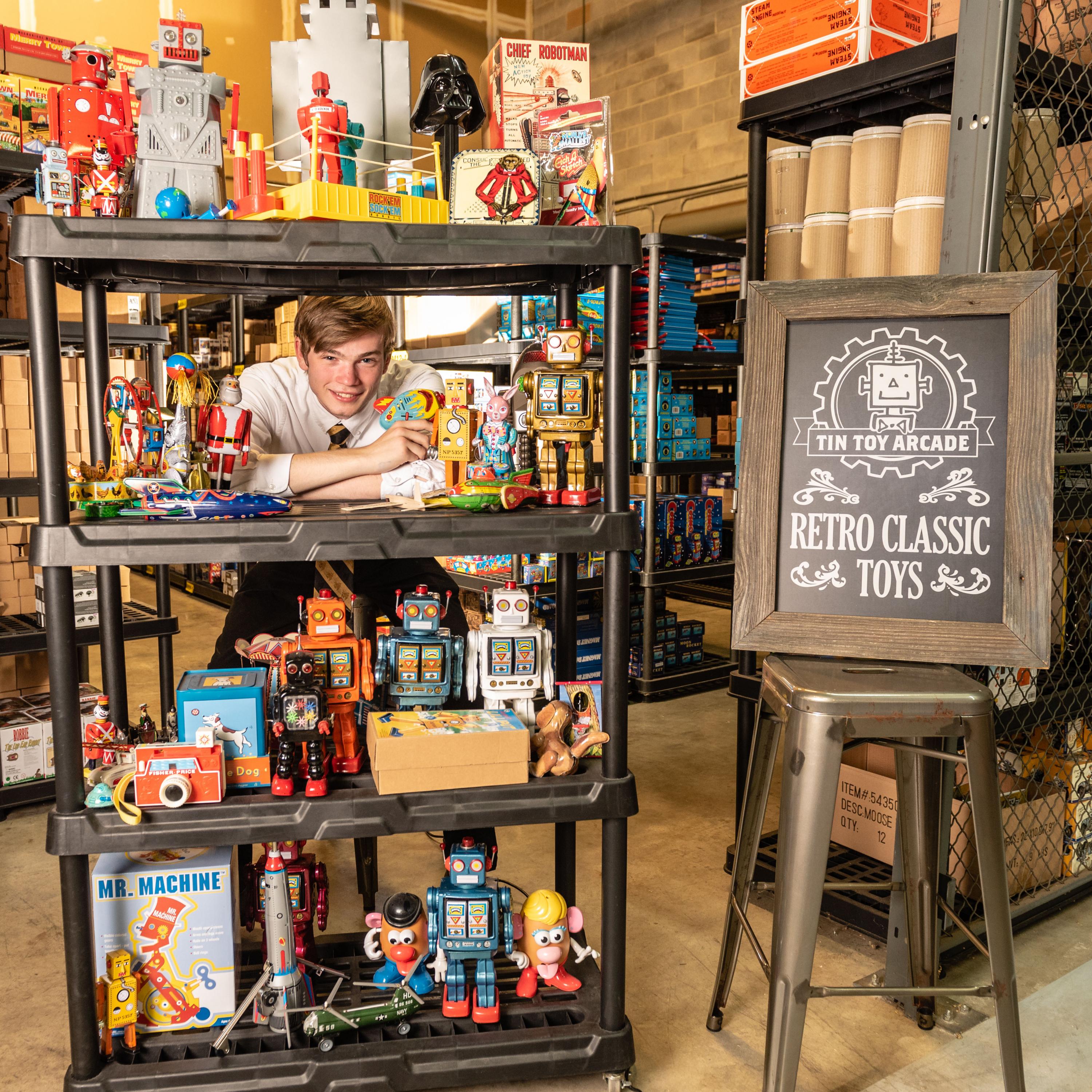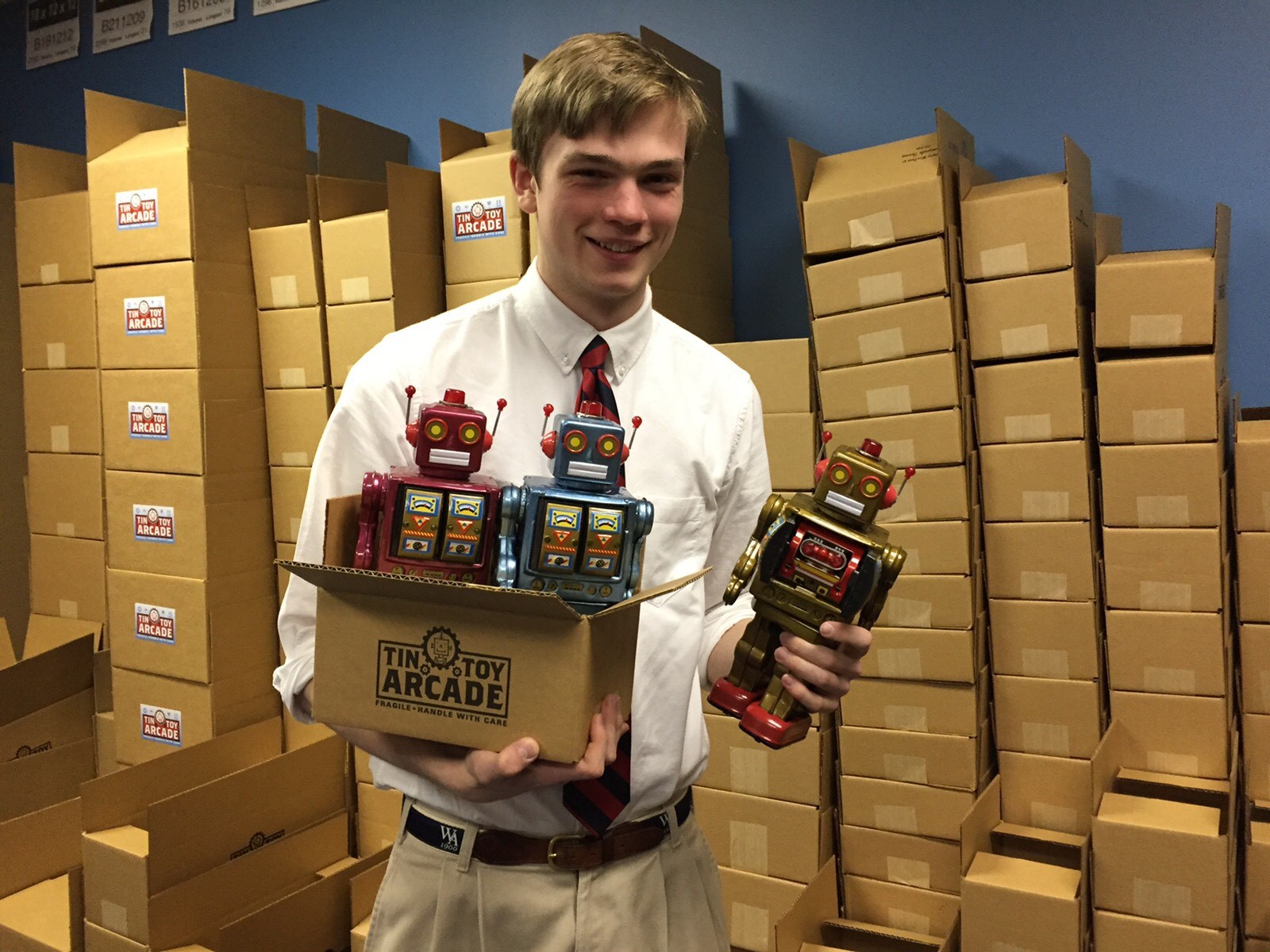It’s not uncommon to see young children selling refreshments at a neighborhood lemonade stand during the summer. What’s unexpected is a kindergartner building off that initial entrepreneurial experience and starting a business selling vintage toys to customers all over the world.
That kid, Aaron Brown, is now a second-year undergraduate student in the H. Milton Stewart School of Industrial and Systems Engineering (ISyE). The initial idea for his company came after he visited the Museum of Tin Toys in Yokohama, Japan, where he saw hundreds of original tin toys on display. Brown, who enjoyed playing with the tin toys his grandparents and parents had handed down to him, wanted to make these vintage collectibles available to others. And thus — with a box of tin toys, a simple website, and a $500 loan from his parents — Brown started TinToyArcade.com (TTA).
Now a 12-year-old company, TTA employs seven people — including Brown’s parents — and is the sole source for thousands of vintage and retro-type toys — everything from bolo paddles to cap guns to Brown’s favorite toy: D-Cell the robot.
“D-Cell is a spinoff of one of the first battery-operated robots,” Brown explained. “He opens his chest, which contains firing pistols, and spins around as he’s firing the guns. Then his chest closes, and D-Cell walks again. It’s a pretty cool toy.”
The company has provided props for numerous TV shows and movies: iCarly, Heroes, Interstellar, and Men in Black, among others. The prop master for Tomorrowland came calling, looking for $2,000 worth of robots to blow up in one of the movie’s more spectacular scenes.
Brown has grown TTA from his parents’ living room to its current warehouse near the Atlanta airport. He instituted same-day shipping for orders placed prior to 2 p.m. on weekdays. He also streamlined the order fulfillment process through simple steps, such as putting the most popularly selling toys closest to the front of the warehouse. Employees wear iPods on their arms that tell them where in the warehouse a particular toy is located and which items are needed for order fulfillment. The warehouse’s inventory syncs with the arm tech in real time.
Brown arrived at Georgia Tech in 2017 as something of a self-taught industrial engineer. He had attended ISyE’s week-long summer camp, Mission Possible, as a high school sophomore, and quickly realized that ISyE was the perfect major to help him run TTA more efficiently. Now his studies are providing him with the opportunity to learn the theory behind his trial-and-error supply chain optimization.
“I found out in high school that I can teach myself almost anything — how to get a warehouse working, how to build a database — if I have enough time,” Brown said. “But I don’t have the math foundation at all, and I can’t really explain why my system [for TTA] works, except that I can explain what didn’t work and why my new method works better. I can’t explain queuing theory or bin packing. I know these words, because I’ve heard them, but I’ve never used the processes taught here [at ISyE]. And I’m super excited to be able to use what I’ve learned to explain what I’ve done, and how to improve it.”
Despite the fact that Brown is just now beginning his ISyE-specific studies, he has solid proof that his system functions: During the 2016 holiday season, hundreds of orders unexpectedly came in when both the Atlanta Journal-Constitution and Wall Street Journal featured articles about TTA.
“It was madness,” he remembered. “On a day just before Christmas, we received over 1,500 orders. Never on the same day have we received that many orders. Our system handled it, which I didn’t expect at all. I was so happy it worked!”
Tin Toy Arcade is a successful online retailer — in fact, Amazon is the company’s main competitor. Brown attributes TTA’s ability to challenge Amazon largely because of its same-day shipping policy. In addition, TTA carries exclusive toy lines from manufacturers in Germany and India.
He met Joseph Wagner, his German manufacturer, through the international New York Toy Fair.
“I snuck onto the floor of the toy fair when I was nine — the age requirement is 18 — and started handing out business cards,” Brown said, laughing. “I ran into Joseph, who’s the last tin toy manufacturer in Nuremberg, which is the home of the original tin toys.”
When Brown was in ninth grade, he visited Wagner in Nuremberg and learned more about the international history behind the original tin toys.
“Joseph’s manufacturing plant is his garage,” Brown said. “After WWII, he bought the Nazis’ bullet presses and turned them into machines to make toys.”
The toys are litho-plate printed: Paint — now lead- free — is spread onto flat tin, which is then put onto the metal press that indents the toy’s shape.
When asked what delights him so much about selling these retro toys, Brown responded, “I think it comes from the first day of this business, at an art show. I was selling photographs of my grandparents’ toys and displaying the actual toys alongside the photos. One of my first customers was probably in her mid-40s, and she was super happy to see the toys she grew up with. She brought over her four kids and told them that these were the toys she had when she was a kid. She loved them, and then the kids instantly loved them too. There’s no disconnect between generations with these toys.
“I think this is one of the best jobs out there, playing with and selling toys for a living,” Brown added. “We say that we sell happiness. I’ve kept the legacy of them alive. Seeing how I can improve TTA is a lot of fun, and in turn, that made me an engineer.”

